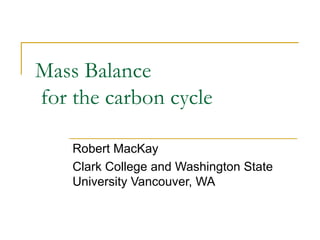
Using a Mass Balance Model to Understand Carbon Dioxide and its Connection to Global Warming
- 1. Mass Balance for the carbon cycle Robert MacKay Clark College and Washington State University Vancouver, WA
- 2. Camping
- 3. Student Learning Goals Use a model to estimate the future concentrations of carbon dioxide under several different assumed emission scenarios. Learn how different carbon dioxide emission scenarios influence our best prediction of future global temperatures. Learn how a mass balance model applies to the global atmosphere. Calibrate a model with recent observations. Understand the sluggishness of the carbon cycle to anthropogenic changes. Synthesize results into a well written summary. Accurately read graphical information. Read and interpolate data from a table of values.
- 5. From page 212 IPCC “Climate Change 2007 The Physical Science Basis”
- 6. IPCC 2007 Figure 7.3
- 7. IPCC 2007 Figure 7.3 The Global Carbon Cycle for the 1990s . Red anthropogenic black preindustrial. From the diagram above, estimate the fraction of total anthropogenic carbon emissions that are attributable to land use changes.
- 8. IPCC 2007 Figure 7.3 The Global Carbon Cycle for the 1990s . Red anthropogenic black preindustrial. From the diagram above, estimate the fraction of total anthropogenic carbon emissions that are attributable to land use changes. 1.6/(8.0)=0.20 =20%
- 9. IPCC 2007 Figure 7.3 The Global Carbon Cycle for the 1990s . Red anthropogenic black preindustrial. From the diagram above, estimate the fraction of all carbon emitted from human activity that is still in the atmosphere.
- 10. IPCC 2007 Figure 7.3 The Global Carbon Cycle for the 1990s . Red anthropogenic black preindustrial. From the diagram above, estimate the fraction of all carbon emitted from human activity that is still in the atmosphere. 165/(244+39)=58%
- 11. Basic Model What’s missing from this carbon cycle model?
- 12. Basic Model What’s missing from this carbon cycle model? Rock (Lithosphere) and Humans
- 13. [ CO2 ]t +1 = ( A0,t + a0 St ) + ( A1,t e−1 / τ1 + a1 * St ) + ( A2,t e−1 / τ 2 + a2 * St ) + ( A3,t e−1 / τ 3 + a3 * St ) IPCC 2007 page 213 τ 0 = infinite a0=0.217 a1=0.259 τ 1 =172.9 a2=0.338 τ 2=18.51 a3=0.186 τ 3=1.186 Introduction to multi-box models (lecture notes) http://www.atmosedu.com/WSU/esrp310-550/notes/BoxModels/MatrixPractice1.pdf “Normal modes and the transient response of the climate system” , GRL MacKay and Ko, 1997 (http://www.atmosedu.com/WSU/esrp310-550/OceanModel.pdf )
- 14. Model and preliminary assignment http://www.atmosedu.com/physlets/GlobalPollutio
- 16. Conclusion The model can be used in an interactive lecture discussion or as an assignment. Implements the 2007 IPCC carbon impulse response function. Captures both the fast response and the sluggishness of the carbon cycle. Helps students understand how policy changes today have limited short term (20 yr) influence but important long term (60 yr) influence. Gives students more practice using graphical information. Open ended questions allow student to think for themselves.